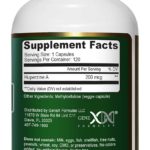Curious about the effects of SAM-e and wondering how long it takes to see results? S-Adenosyl-L-Methionine (SAMe) is a naturally occurring compound that has gained popularity as a dietary supplement due to its potential therapeutic effects on mood, joint health, and liver function. It is involved in the synthesis of neurotransmitters, DNA, proteins, and other vital molecules in the body. SAMe’s role in managing mood disorders, such as depression, and supporting joint health, particularly for individuals with osteoarthritis, has been widely explored. However, it’s important to remember that the effectiveness of SAMe can vary from person to person. Consulting a healthcare professional is always recommended before starting supplementation to ensure safe and effective use.
Factors Affecting SAM-e’s Effectiveness
Metabolism and Absorption
SAM-e’s effectiveness can be influenced by factors such as metabolism and absorption. Metabolism refers to how the body breaks down and processes substances, while absorption refers to how the body absorbs and utilizes SAM-e. Individual variations in metabolism and absorption can affect how quickly SAM-e is processed and utilized in the body.
Metabolism and absorption can be influenced by various factors, including age, genetics, overall health, and the presence of any underlying medical conditions. For example, individuals with certain liver or gastrointestinal disorders may have impaired absorption of SAM-e. Similarly, age-related changes in metabolism can impact the body’s ability to efficiently process SAM-e.
It’s important to keep in mind that SAM-e’s effectiveness can vary from person to person based on these individual factors. It may be necessary to adjust the dosage or duration of use to optimize the benefits of SAM-e based on individual needs.
Dosage
The dosage of SAM-e can also impact its effectiveness. SAM-e is available in different strengths and forms, including tablets, capsules, and powder. The recommended dosage of SAM-e can vary depending on the specific condition being addressed and individual factors such as age, weight, and overall health.
For mood disorders, including depression, the typical dosage range of SAM-e is often between 400-1600 mg per day. However, it’s important to note that individual responses to SAM-e can vary, and it’s best to start with a lower dosage and gradually increase if necessary. Consulting with a healthcare professional can provide guidance on the appropriate dosage based on individual needs.
Duration of Use
The duration of SAM-e supplementation can also impact its effectiveness. SAM-e is not a quick fix, and it may take time for its benefits to be fully realized. Some individuals may notice improvements in their mood or joint health within a few weeks of starting SAM-e supplementation, while others may require several months to experience noticeable effects.
Consistency is key when it comes to SAM-e supplementation. It’s important to take SAM-e regularly as prescribed and give it time to work. It’s not uncommon for individuals to experience gradual improvements over time rather than immediate results.
The duration of use may also vary depending on the condition being addressed. For example, individuals using SAM-e for mood disorders may benefit from long-term supplementation to maintain stable mood levels, while those using SAM-e for joint health may find relief with shorter durations of use.
Individual Variability
Lastly, individual variability is an important factor that can affect SAM-e’s effectiveness. SAM-e may work differently for different individuals due to variations in biochemistry, underlying health conditions, and other individual factors. What works for one person may not work the same way for another.
It’s important to approach SAM-e supplementation with an understanding that individual responses may vary. Patience and open communication with healthcare professionals can help in fine-tuning the use of SAM-e to maximize its effectiveness for each individual.
SAM-e for Mood Disorders
SAM-e as an Adjunct Therapy
SAM-e has shown promise as an adjunct therapy for mood disorders, particularly depression. As mentioned earlier, SAM-e is involved in the synthesis of neurotransmitters that play a role in mood regulation. By increasing the availability of these neurotransmitters, SAM-e may help alleviate symptoms of depression and improve overall mood.
SAM-e is often used as an adjunct therapy alongside conventional antidepressant medications. Research has suggested that SAM-e supplementation may enhance the effects of antidepressants and potentially reduce the dosage required. However, it’s important to note that SAM-e should not be used as a replacement for prescribed medications without consulting a healthcare professional.
Onset of Action for Depression
The onset of action for SAM-e in the treatment of depression can vary. Some individuals may start to experience improvements in mood and a reduction in depressive symptoms within a few weeks of starting SAM-e supplementation. However, it’s essential to remember that individual responses to SAM-e may differ, and it may take longer for others to notice the benefits.
It’s recommended to give SAM-e a fair trial of several weeks to several months to assess its effectiveness in alleviating depressive symptoms. Regular communication with a healthcare professional is essential to monitor progress and make any necessary adjustments to the treatment plan.
Response Time for Other Mood Disorders
SAM-e’s effectiveness in treating other mood disorders, such as bipolar disorder or anxiety disorders, may also vary. While SAM-e’s role in mood regulation suggests potential benefits for these conditions, more research is needed to determine its specific effectiveness.
Individual response times may also differ for these mood disorders. It’s important to consult with a healthcare professional to discuss the potential benefits and appropriate duration of SAM-e supplementation for specific mood disorders.

SAM-e for Joint Health
SAM-e and Osteoarthritis
SAM-e has been studied for its potential benefits in managing joint health, particularly in osteoarthritis. Osteoarthritis is a degenerative joint disease characterized by the breakdown of cartilage and inflammation in the joints.
SAM-e is thought to support joint health by promoting the synthesis of cartilage and synovial fluid, which act as natural shock absorbers and lubricants for the joints. By maintaining the integrity of cartilage and reducing inflammation, SAM-e may help alleviate joint pain and improve overall joint function in individuals with osteoarthritis.
Time Frame for Joint Pain Relief
The time frame for experiencing joint pain relief with SAM-e can vary among individuals with osteoarthritis. Some individuals may start to notice a reduction in joint pain within a few weeks of starting SAM-e supplementation, while others may require several months.
Consistency in taking SAM-e as prescribed is crucial for experiencing its potential benefits for joint pain relief. It’s important to note that SAM-e supplementation should be viewed as a long-term approach to support joint health rather than a quick fix for immediate pain relief.
Improvement in Joint Function
In addition to pain relief, SAM-e may also have a positive impact on joint function in individuals with osteoarthritis. By preserving cartilage and reducing inflammation, SAM-e may help improve range of motion, flexibility, and overall joint function.
Again, individual response times may differ, and it’s essential to give SAM-e sufficient time to exert its effects on joint function. Regular communication with a healthcare professional can help monitor progress and make any necessary adjustments to the treatment plan.
SAM-e for Liver Function
SAM-e and Liver Disorders
SAM-e has been studied for its potential benefits in supporting liver function in certain liver disorders. The liver plays a vital role in detoxification, metabolism, and the production of essential biochemicals. Liver disorders, such as non-alcoholic fatty liver disease and liver cirrhosis, can impair liver function and lead to various health complications.
SAM-e may help improve liver function by promoting the production of liver enzymes involved in detoxification and the synthesis of bioactive compounds. Additionally, SAM-e’s antioxidant properties may help reduce oxidative stress and inflammation in the liver.
Timeline for Liver Health Improvement
The timeline for experiencing improvements in liver health with SAM-e can vary based on the specific liver disorder and individual factors. Research indicates that SAM-e supplementation may lead to improvements in liver function markers over several weeks to months.
It’s important to combine SAM-e supplementation with other lifestyle modifications and medical interventions as prescribed by a healthcare professional for managing liver disorders effectively. Regular monitoring of liver function through blood tests and ongoing communication with a healthcare professional is essential for assessing progress and adjusting the treatment plan as needed.

SAM-e Safety and Considerations
Consulting a Healthcare Professional
Before starting SAM-e supplementation, it’s crucial to consult with a healthcare professional. They can provide personalized guidance and ensure that SAM-e is appropriate for individual needs and health conditions. They can also help determine the appropriate dosage and duration of use based on specific goals and considerations.
Potential Side Effects
SAM-e is generally considered safe and well-tolerated. However, like any dietary supplement, it can potentially cause side effects in some individuals. Common side effects of SAM-e may include gastrointestinal symptoms such as nausea, diarrhea, and flatulence. These side effects are typically mild and temporary.
In rare cases, SAM-e supplementation may trigger symptoms such as anxiety or mania in individuals with bipolar disorder or other mood disorders. If any concerning side effects occur while taking SAM-e, it’s important to seek medical attention and consult with a healthcare professional.
Drug Interactions
SAM-e may also interact with certain medications and substances. It’s essential to inform a healthcare professional about all medications, supplements, and substances being taken to identify and manage potential interactions. SAM-e may interact with medications such as antidepressants, levodopa, and certain medications metabolized in the liver.
A healthcare professional can provide guidance on potential drug interactions and help adjust medications or SAM-e dosage if necessary. Regular communication with a healthcare professional is crucial throughout the supplementation period to ensure safety and optimize effectiveness.
Conclusion
SAM-e, or S-Adenosyl-L-Methionine, is a naturally occurring compound that has gained attention for its potential therapeutic effects on mood, joint health, and liver function. Its effectiveness can be influenced by factors such as metabolism and absorption, dosage, duration of use, and individual variability.
In the management of mood disorders, SAM-e has shown promise as an adjunct therapy for depression and potentially other mood disorders. The onset of action may vary, and individual responses to SAM-e can differ. Patience, regular communication with a healthcare professional, and compliance with prescribed treatment plans are important for optimizing its effectiveness.
For joint health, SAM-e may help alleviate joint pain and improve joint function in individuals with osteoarthritis. Time frames for experiencing relief and improvements may vary, and long-term supplementation is often necessary for maintaining joint health.
SAM-e’s potential benefits for liver function in certain liver disorders have also been studied. Improvements in liver health markers may be seen over several weeks to months with SAM-e supplementation. Medical interventions and lifestyle modifications should be combined with SAM-e supplementation, and regular monitoring of liver function is important.
It’s essential to consult with a healthcare professional before starting SAM-e supplementation. They can provide personalized guidance, assess individual factors, and ensure safety. Potential side effects and drug interactions should be considered, and ongoing communication with a healthcare professional is crucial throughout the supplementation period.
SAM-e, when used appropriately and under the guidance of healthcare professionals, may offer potential benefits for mood disorders, joint health, and certain liver disorders. Every individual is unique, and individual responses to SAM-e may vary. It’s important to approach SAM-e supplementation with realistic expectations, patience, and open communication with healthcare professionals for safe and effective use.








